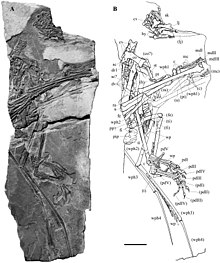Carniadactylus
| Carniadactylus | |
|---|---|

| |
| Holotype | |
| Scientific classification | |
| Domain: | Eukaryota |
| Kingdom: | Animalia |
| Phylum: | Chordata |
| Order: | †Pterosauria |
| Family: | †Eudimorphodontidae |
| Subfamily: | † Eudimorphodontinae
|
| Genus: | †Carniadactylus Dalla Vecchia, 2009 |
| Species: | †C. rosenfeldi
|
| Binomial name | |
| †Carniadactylus rosenfeldi (Dalla Vecchia, 1995)
| |
| Synonyms | |
| |
Carniadactylus is a genus of pterosaur which existed in Europe during the Late Triassic period (Norian stage,[1] about 217-213 million years ago).[2] The genus contains a single species, Carniadactylus rosenfeldi.
Description
Carniadactylus was similar in appearance and anatomy to its close relative Eudimorphodon, though it was significantly smaller. Like Eudimorphodon, it is notable for its complex multi-cusped teeth. Despite their similarities, the size difference between these two pterosaurs likely meant that they occupied different niches and relied on different food sources. This is supported by studies of their teeth. While similar in construction, the teeth of Carniadactylus show little to no wear, unlike the larger, fish-eating Eudimorphodon, which may have been able to chew its food. The smaller Carniadactylus probably fed on smaller, soft-bodied prey like worms and insect larvae.[3]
Classification
In 1995 the
It soon became clear however, that in
To avoid this Dalla Vecchia in 2009 created the new genus Carniadactylus. The type species is Carniadactylus rosenfeldi. The genus name is derived from Carnia, the name of the region the fossil was found, and Greek daktylos, "finger", a reference to the wing finger typical of pterosaurs. A second specimen, MPUM 6009, is the paratype, consisting of an almost complete skeleton that however has been largely preserved as an impression only. It is a third shorter than the holotype, that itself indicated a wingspan of about seventy centimetres. The disparity was by Dalla Vecchia explained as intraspecific variability.[5] In 2015, Alexander Kellner named a separate genus for MPUM 6009: Bergamodactylus.[6] Dalla Vecchia however, retained MPUM 6009 within the taxon Carniadactylus rosenfeldi in 2018.[7]
According to earlier analyses by
| Eopterosauria |
| ||||||||||||||||||||||||||||||||||||||||||
In 2020 however, a study upheld by Matthew G. Baron about early pterosaur interrelationships found Carniadactylus to group with
See also
References
- ^ Barrett, P. M., Butler, R. J., Edwards, N. P., & Milner, A. R. (2008). Pterosaur distribution in time and space: an atlas. Zitteliana, 61-107. [1]
- ^ Müller R.T., Ezcurra M.D., Garcia M.S., Agnolín F.L., Stocker M.R., Novas F.E., Soares M.B., Kellner A.W.A. & Nesbitt S.J. (2023). ”New reptile shows dinosaurs and pterosaurs evolved among diverse precursors”. Nature 620(7974): p. 589–594. doi:10.1038/s41586-023-06359-z
- ^ Dalla Vecchia F.M., 1995, "A new pterosaur (Reptilia, Pterosauria) from the Norian (Late Triassic) of Friuli (Northeastern Italy), Preliminary note". Gortania, 16 (1994): 59-66
- ^ Dalla Vecchia, Fabio M (2009). "Anatomy and systematics of the pterosaur Carniadactylus (gen. n.) rosenfeldi (Dalla Vecchia, 1995)". Rivista Italiana de Paleontologia e Stratigrafia. 115 (2): 159–188.
- PMID 26131631.
- ISSN 2039-4942.
- .
- PMID 26339122.
- PMID 33005485.
